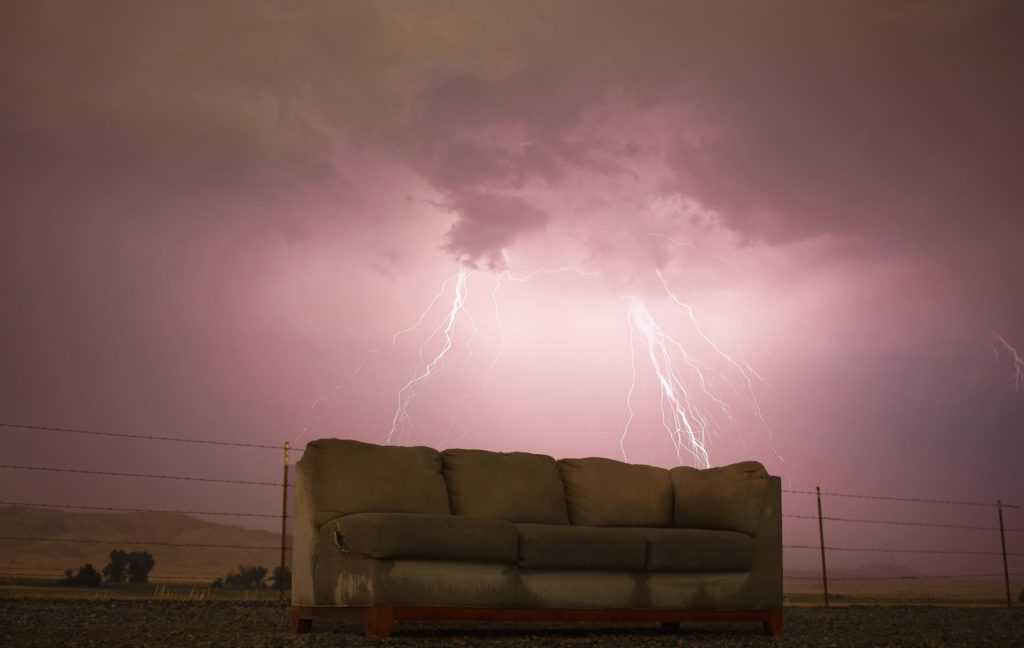You listened to experts and purchased a polyester couch. Why?

Polyester blends well with other fabrics, it’s non-allergenic, and purchasing one won’t break the bank. But what is the best way to clean a polyester couch? We know a thing or two about professional upholstery cleaning here at Paul’s Cleaning (Melbourne) Company, so we put together this handy guide to help you.

Contact us today!
What is Polyester?
Otherwise known as polyethylene terephthalate, this material is synthetic, which means humans make it. This is different from natural materials like cotton or hemp.
As we’ve mentioned, polyester is not expensive and stronger than other fibers. This is a winning combination when it comes to sofas, which are known to take a beating.
Due to the durability, there are a few ways you can keep it looking fantastic. We recommend reading the entire guide before starting, so you go into the job knowledgeable.
Couch Cleaning Toolset:
- A vacuum;
- White vinegar;
- Baking soda;
- Warm water;
- A bucket;
- A few towels;
- A scrub brush or two;
- Time;
- Patience.
Vacuum Polyester Couches
The first thing to do when cleaning any couch is to use a vacuum. All kinds of objects get lost in the cushions like crackers, crumbs, nuts, and the like.
- Before you turn on the vacuum, be sure there aren’t any loose coins or valuables lying around. Besides food, it’s easy to lose earrings and other items like that too.
- One you’ve picked up all the things you don’t want to go into the vacuum, start sucking.
- Let that thing get into every nook and cranny you can fit it into. Don’t be shy.
- Crumbs and dirt are wonderfully talented at hiding, so give it a once over, and then vacuum your couch again.
- Be sure to hit each pillow and cushion on all sides.
- Vacuum the arms, top, and behind the sofa. These are areas that go unnoticed.
- Additional cleaning if you have pets, especially hairy ones like many types of Huskies. Animal hair can accumulate quickly, which is why it’s a good idea to stay on top of it. The more animals you have, the more often you should vacuum.
Baking Powder & Polyester
Sprinkle some baking powder all over your sofa. If you like, there are scented kinds in the cleaning aisle of the store. The idea is to get some of the odors off your couch.
Just think about how much sweat and bodily fluids are expelled on that sofa. If you have a few people in your family, odds are someone slept there and drooled.
We all leave odors behind. It’s nothing to be ashamed of. Baking soda is a fantastic way to get rid of those less-than-appealing scents.
All you do is sprinkle it lightly on every area that you can.
Let it sit for at least ten minutes, but if you can let it sit overnight, even better. The longer it sits, the more odor it will absorb.
We realize letting it sit all night is difficult, but it will be fresher if you do. Baking soda neutralizes odors by contributing both acidic and basic molecules. Once you’ve waited the appropriate amount of time, vacuum all the baking soda off your sofa and cushions. Be sure to get it all.
Spot Clean Your Couch
Now, you want to give your couch a good look over. Do you know where all the spots are?
Odds are you know about some, and others will come as a surprise. This is the point in your couch cleaning where you try to get rid of them all. This can be done with ingredients you can find in your home or a store-bought spot remover. The choice is up to you.
If you take a quart of warm water, a teaspoon of white vinegar, and a teaspoon of mild laundry detergent, you can create a spot remover that will work as well as a store-bought cleaner.
When cleaning spots, you should use a towel that is the same color as your sofa or near that color. You don’t want to leave white specks on a dark couch or vice versa.
- Dab a small area to start.
- Make sure your mixture is working.
- Keep dabbing with the towel as much as you can.
- Don’t wipe it in long strokes.
For more prominent stains, work from the inside out. Keep at it. This is where patience comes in. Not all stains are equal. Some can be removed easily, while others take time.
If you can’t get it all the first time around, keep trying. Polyester is made to resist stains, so your spot removal shouldn’t be too difficult.
Dry Couch Cushions
Once you’ve finished with your spot cleaning, you want to get those wet spots dry as soon as possible. There are several ways you can speed up the process.
- One way is to let the sofa cushions rest in the sun until they dry. You can get a dry towel and start dabbing to pick up any wetness.
- Or you can accelerate the process with a hairdryer.
The critical thing to remember is that you don’t want to leave your sofa soaking wet.
- Get up as much water out as you can.
- Wet fabrics can become infested with mold, which can be quite an issue.
- Mold can be pretty bothersome to those who are allergic. Sufferers can experience a runny nose, red eyes, rash, and sneezing. Mold can even be linked to shortness of breath.
As you can see, mold is an issue that you want to prevent. Getting rid of mold is very difficult, and it can ruin your couch.
So do yourself a favor and dry those wet spots as best as you can to avoid any problems. It would be a shame if your cleaning venture ended up with you needing to replace your sofa due to mold.
Brush Your Couch
Now that your sofa is dry, get a scrub brush that’s clean and dry. Using a small, circular motion, start to revitalize the material on your couch. While polyester is durable, you just put those fibers through a bit of a workout. By brushing them out, your threads will jump up again and come to life, comments cleaning expert Martina Simons.
Pay special attention to the areas where you did the spot cleaning. Wetness can cause materials to flatten. This is another reason why using a clean scrub brush is a great way to get those polyester strands to stand for attention.
Steam Clean Your Couch
Sometimes stains and spots are stubborn, and a steam cleaner can get places that you can’t. How?
These beautiful machines allow for purified steam and detergent to permeate the materials and get deep down in the fabric to suck then suck back in, comment experts at Complete Home Filtration. Steam is the result of boiling water, which is why you need a machine like this. There are a ton of other benefits that steam cleaning your home can bring.
- First, it’s eco-friendly because the primary source is H2O.
- Second, steam cleaners kill viruses, mold, and other germs that could be hiding inside the fibers of your cushions.
Allergens are no match for the hot steam either, and steam cleaners are lovely at eliminating odors.
The thing you need to know is that using a steam cleaner is safe, but you need to know what you’re doing. If you have questions about cleaning, don’t hesitate to give us a call.
How To Deal With Polyester Emergencies
We all have accidents. Sometimes it’s a glass of red wine, and others, it’s a bit of that chocolate you were eating. Sofas take all kinds of abuse because we spend so much of our time relaxing on them.
When you or someone in your house spills on your sofa, the best way to treat it is right away. You shouldn’t wait until it’s time to clean the couch before getting rid of those stains. It’s always best to take care of spills as soon as you can.
Some things, like red wine, can leave significant stains that are nearly impossible to remove. Blot that mess as much as you can. Then pour baking soda on it and let it sit for a few minutes. The baking soda will absorb the liquid. Use a vacuum to pick up the baking soda and then repeat.
Do this until all the wetness is absorbed. Then, use the spot cleaning mixture we gave you above and start dabbing. If the cushion is too wet, use the baking soda to pull it out. Keep repeating these steps until you can’t see the red wine anymore.
Is Polyester Better?
When it comes to a couch, there are tons of choices for materials. Sofas come in leather, cotton, linen, acetate, wool, hemp, silk, polypropylene, acrylic, nylon, and rayon. Those are a ton of choices, and they all have beautiful attributes.
The nice thing about polyester is that it can be woven with other fibers. While it can’t be mixed with leather, cotton and wool are great options. When polyester is blended with natural fibers, you end up with material that is breathable and durable. The best of both worlds!
But, it’s essential to keep on top of any spills and regularly clean your sofa.
Call Us!
Sometimes you just don’t have the time to clean your couch. Or maybe there’s a stain that you just can’t get rid of. At Paul’s Cleaning Company, we’ll send out one of our experts to look at your job. Then we’ll do the vacuuming and pre-spray your sofa to get rid of any dirty patches.
Then, our professional will use pressure to infiltrate your couch with our detergent, which is powerful but harmless to you and your family. When we’re done, you’ll see your sofa come back to life with its original color.
We also offer a protector for an additional cost.
Cleaning A Polyester Couch, Notes
Cleaning a couch, no matter what material it’s made from, is no small job. It takes time and dedication. If you have both of those, use the steps we provided above, and you’ll do an excellent job.
If you can’t seem to find the time to clean that polyester couch of yours, give us a call, and we’ll be happy to send one of our professionals out to help you.






